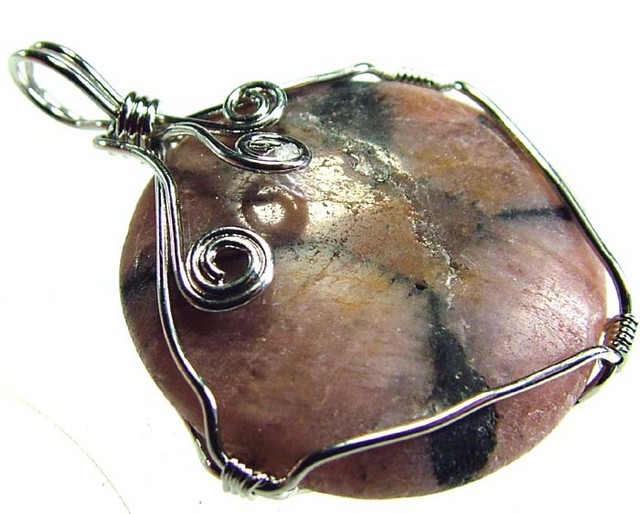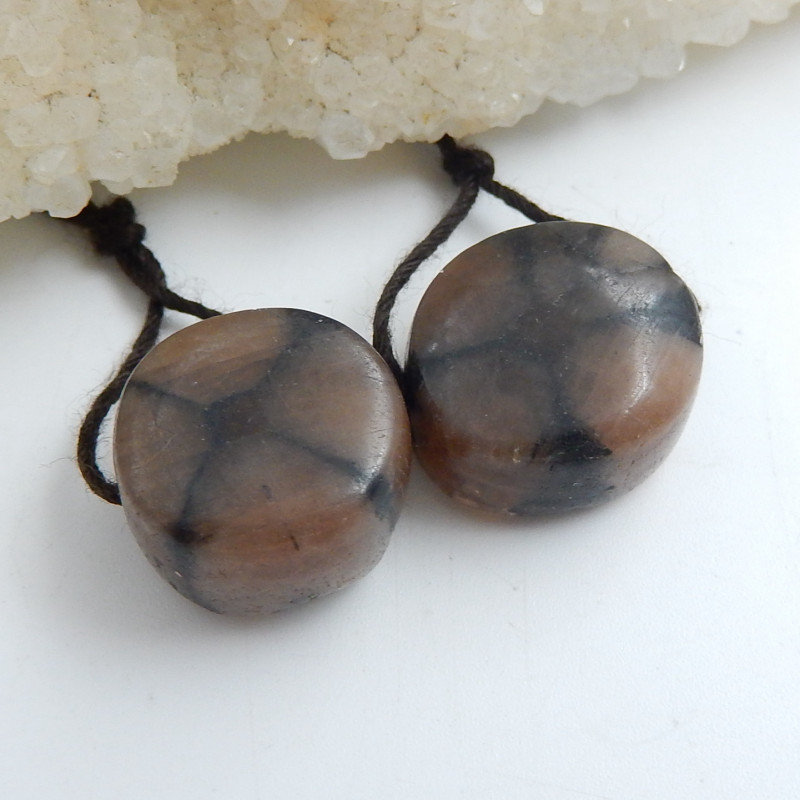
キアストライト宝石:特性、意味、価値など
 キアストライト(発音:ky-AS-tuh-lyte)は、クリーム色から茶色のアンダルサイト宝石で、黒い幾何学的な十字模様が見られます。多くの人はキアストライトを「クロスストーン」と呼びます。
キアストライト(発音:ky-AS-tuh-lyte)は、クリーム色から茶色のアンダルサイト宝石で、黒い幾何学的な十字模様が見られます。多くの人はキアストライトを「クロスストーン」と呼びます。
キアストライトはアンダルサイトと同じものですか? まあ、同じです。アンダルサイトは独自の鉱物ですが、ビリジンとキアストライトの2つの変種があります。つまり、すべてのキアストライトはアンダルサイトですが、すべてのアンダルサイトがキアストライトというわけではありません。
キアストライトは希少ですか?はい、非常に希少です。宝石質のアンダルサイトはすでに希少ですが、キアストライトはさらに希少な種類です。
販売されているキアストライトを見て回ろうかと考えている方、または有名な「十字石」についてもっと知りたい方は、キアストライトの特性、治癒力、意味などをすべて詳しく説明するので、ぜひお読みください。

キアストライト石について
キアストライトは、十字模様が特徴で、通常は不透明な茶色の半貴石で、装飾品として用いられます。「クロスストーン」の他に、キアストライトには以下のような別名があります。
ラピスラズリ
ラピス・クルシアトゥール
マクル
マルテサイト
クルサイト/クルサイト
キアストライト
さらに、販売者はキアストライトを「トラピッチェ アンダルサイト」とラベル付けする場合があります。
トラピッチェ宝石は、特殊な成長条件により、 内包物が「スポーク」状に対称的に見られることが多く、希少価値が高く、人気があります。最も高価なのはコロンビア産のトラピッチェ・エメラルドです。
占星術的には、キアストライトの星座石は天秤座と山羊座を飾ります。
工業的には、キアストライトのようなアンダルサイトは、その優れた耐熱性から、窯や炉の耐火ライニングに使用されています。

キアストライトの仕様と特徴
キアストライトは、アルミニウムケイ酸塩鉱物であるアンダルサイトの一種です。化学式はAl₂SiO₃またはAl₂(SiO₃)Oです。アンダルサイトには、キアストライトのほか、ビリジンやアンダルサイト自体も含まれます。
他の種類と比較して、キアストライトは硬度と密度が低いです。ほとんどのアンダルサイトはモース硬度6.5~7.5、密度は3.12~3.17です。一方、キアストライトはモース硬度5~5.5、密度は3.00~3.15です。
さらに、アンダルサイトは強い多色性を持つことで知られています。ほとんどのキアストライトは多色性を示しませんが、薄く透明から半透明のスライスでは多色性が見られます。
トラピッチェ宝石の中で、キアストライトは高い対称性を持たない(擬正方晶系)という点で独特です。また、正方形の断面を持つ柱状結晶を形成できることも特徴です。自形結晶や粒状/放射状の集合体を形成することもあります。
キアストライトの鉱物特性は次のとおりです。
モース硬度:5~5.5
色: 白、灰色、黄色、茶色、緑、茶色がかったピンク、緑がかった灰色、茶色がかった灰色; 黒、灰色、または緑の十字模様
結晶構造:斜方晶系
光沢:ガラス質(ガラス状)からマット
透明性:半透明から不透明、まれに透明
屈折率:1.62~1.64
密度:3.00~3.15
へき開:明瞭、[110]方向への1方向へ(?)
骨折:貝殻下骨折まで
縞模様:白
発光:蛍光が時々存在する - 南西-紫外線では茶色または黄緑色
多色性:薄い切片や透明標本の中心部では見えるが、通常は観察できない

キアストライトの意味と歴史
キアストライトは、活力、変化、そしてバランスを象徴します。また、守護と献身の象徴でもあります。特に精神的な意味での献身との結びつきは、時代を超えて様々な文化において、キアストライトの精神的な意味の解釈に反映されてきました。
似たような伝説を持つ鉱物として、スタウロライトがあります。キアストライトと同様に「妖精の十字石」という異名を持ちます。何世紀にもわたって、人々はこれらの石の四つ角に力があると信じ、収集してきました。
キアストライトの十字架の意味に関する古代の解釈には、神々からの印、幸運のお守り、そして守護の護符などが含まれます。キアストライトは、邪眼、魔術、あるいは不幸から身を守るためによく使われていました。
ネイティブアメリカンは歴史的に、儀式の際に守護石としてキアストライトとスタウロライトを用いてきました。あるチェロキー族の部族は、涙が十字形だったユンウィ・ツンスディ(「小人」)の伝説を語り継いでいます。
しかし、歴史を通じてキアストライトの主な解釈はキリスト教の十字架と関連付けられるようになりました。
初期の歴史
「キアストライト」という名前は、ギリシャ語の「chiastos」に由来しており、「十字形」または「斜めに配置された」を意味し、ギリシャ文字の「chi 」が「X」に似ていることに由来しています。
キアストライトの最初の記録は、オランダの地理学者ヨハネス・デ・レートによる 1648 年の本、 『De Gemmis et Lapidibus』 (宝石と石のラテン語)に描かれた絵でした。
しかし、最初の公式な記述は、1754年にスペインの宣教師で古生物学者のホセ・トルビアによって出版され、彼の著書『スペイン自然史のための装置』(スペイン語)に掲載されました。
偶然にも、トルビアの説明は、1798 年にフランスの鉱物学者ジャン=クロード・ドゥラメトリーがアンダルサイトを初めて説明する前に行われました。
1500年代以降、キアストライトはスペインのカミーノ・デ・サンティアゴ(聖ヤコブの道)巡礼者への宗教的なお土産として最も広く販売されるようになりました。使徒聖ヤコブの墓の上に建つ大聖堂、サンティアゴ・デ・コンポステーラへのこのキリスト教の巡礼は、9世紀に始まりました。
1,000キロの旅の最終目的地であるこの聖地は、エルサレムとローマとともに、カトリック教徒が罪を赦されるために訪れることができる3つの場所のうちの1つである。
ニューイングランドにおける意義
大西洋の向こう側では、ヨーロッパからの分離派入植者が 1620 年と 1653 年にアメリカのマサチューセッツ州に定住しました。1620 年の巡礼者と 1653 年の清教徒グループはどちらも大部分がキリスト教徒でした。
現在のマサチューセッツ州ランカスターで、入植者たちはキアストライトを発見し、その神秘的で、おそらくは神聖な岩石に魅了されました。彼らはキアストライトをイギリスに送り返しました。キアストライトは王族の間で人気を博し、多くのイギリスの博物館に収蔵されています。入植者たちはボタンやスタッドなどの装飾品にもキアストライトを使用しました。
現代における意義
現在でも、キアストライトはスペインやフランスでは重要な文化財であり、採掘されてカトリック教徒の観光客に販売されており、研磨されてキアストライトのジュエリーに加工されることも多い。
スペインにおけるキアストライトの地元での重要性については、M. Calvo Rebollar の 2016 年の研究「El "lapis crucifer", "piedra de cruz de Compostela": un elemento importante de los patrimonios geológico y culture del NW de España」 (スペイン語で「ラピスの十字架」、「十字架の石」の意味) に詳しく説明されています。コンポステラ」: スペイン北西部の地質学的および文化的遺産の重要な要素」)。
宗教的な記念品以外に、キアストライトは何に使われるのでしょうか?もちろん、癒しのためです!

チアストライトの治癒特性
すべての宝石の色と波動は、ヒーリングストーンとして有用です。キアストライトに見られる茶色と黒の色合いは、この石が他の黒や茶色の宝石と同様に、グラウンディング、保護、そして自然との繋がりをもたらすことを意味します。
しかし、多くのキアストライトはクリーミーな白を基調としており、白い宝石の浄化作用や変容作用を想起させます。また、グレーのキアストライトは、グレーの結晶のバランスと調和を象徴しています。
キアストライト石は、身体的、感情的、精神的な癒しにどのような効果がありますか?
身体の治癒
身体的には、キアストライトは次のような症状の治療に効果があると言われています。
痛風
血液循環不良
神経損傷
脳卒中患者
筋力低下
低血圧
リウマチ
麻痺
感情的な癒しへ!
感情的な癒し
再生と若返りの象徴であるキアストライトは、大きな転換期に心強い味方となるでしょう。回復力と決意を高める力、そして心を落ち着かせる力を持つとされ、変化の時により一層力強く寄り添います。
さらに、このクリスタルはネガティブなエネルギーから身を守る力があり、心の平安、ポジティブな思考、そして問題解決能力を高めると言われています。クリスタルヒーラーは、自己成長を目指す人々にキアストライトを推奨することが多いです。
チャクラヒーリング
チャクラヒーリングは、ブロックされたチャクラ(体のエネルギーセンター)を開き、ネガティブな症状を解消することを目的としています。キアストライトはどのチャクラに作用するのでしょうか?キアストライトはルートチャクラに作用するチャクラストーンです。
ルート(ベース)チャクラは、安全と繋がりを求める根本的な欲求を司ります。キアストライトのチャクラストーンを使うことで、不安や孤立といった閉塞感を、自信と繋がりを感じられるバランスの取れた症状へと変化させることができます。

チアストライト宝石の特性
キアストライトの客観的な価値を決定する際に考慮すべき最も重要な宝石の特性は、色、カット、クラリティ、透明性、および処理です。
色
キアストライトの最も一般的な色は、茶色のベースに黒色の十字模様です。ただし、クリーム色、ピンク色、緑がかった灰色、灰色、赤みがかった色などもあります。特に、淡緑色から濃緑色のキアストライトは人気があります。
十字模様はチューブ状の構造で、直線状のものもあれば波状のものもあります。結晶の柱面が急速に成長したため、炭素やグラファイトなどの内包物は結晶の縁に向かって押し出されました。キアストライトは、黄色と茶色が交互に波打つように現れることがあります。
多くの販売者は、淡いピンクがかった茶色の色合いが最高だと考えています。
カット
キアストライトは、ほとんどファセットカットされることはなく、ほとんどの場合、 カボション、ビーズ、タンブルストーン、または研磨されたスライスにカットされます。キアストライトは一つ一つ異なるため、世界に一つだけのジュエリーが生まれます。
時には、熟練した宝石職人(ラピダリスト)によってカットされたキアストライト球を見かけることもあります。彫刻が施されている場合もあります。

明瞭さ
ご存知の通り、キアストライトの独特な外観は、炭素質包有物、特にグラファイト粒子が幾何学的な形状を形成することによって生じています。(そう、鉛筆に使われているグラファイトと同じものです!)
これは驚くことではありません。アンダルサイトはタイプ II の有色宝石の透明度グレードを持ち、目に見える内包物がいくつかあるのはよくあることです。
しかし、キアストライトの内包物は他のアンダルサイトとは異なり、その価値を高めています。唯一の欠点は、内包物がキアストライトの硬度と耐久性を低下させることです。
透明性
ほとんどのキアストライトは不透明であるため、稀に見られる透明または半透明の標本は、はるかに高い価値を持ちます。ほとんどのキアストライト宝石は、スライスして研磨すると、より透明度が増します。
治療
一般的ではありませんが、アンダルサイト(キアストライトを含む)の標本には、加熱処理や樹脂による亀裂充填が施されています。加熱処理による色の変化は大きくありませんが、亀裂充填によって耐久性と透明度が向上します。
次に、キアストライトはどのように形成されるのでしょうか?

チアストライトの形成と起源
一般的に、キアストライトのようなトラピッチェ鉱物は比較的最近発見されたもので、その形成については研究者の間で完全に一致した見解はありません。しかし、最も広く受け入れられている説は、1934年にアメリカの鉱物学者クリフォード・フロンデル博士によって提唱されました。
フロンデルの理論によれば、キアストライトの「十字」は異なる成長速度によって形成される。変成作用を受ける岩石内部で石が形成されるにつれて、グラファイト不純物がより高濃度になる場所では結晶の成長速度が低下する。
グラファイトまたは炭素質不純物は針状の結晶になり、「凹角」または通常は双晶の会合を示す窪みの周りに集まります。
ほとんどすべてのキアストライト鉱物は、グラファイトを豊富に含む変成岩または変成堆積物中に産出されます。一部のキアストライト結晶は、パラゴナイト、白雲母、マルガライトによって変質しています。
ところで、キアストライトはどこで見つかるのでしょうか?
採掘場所
現在、中国の湖南省は最大のキアストライト結晶を産出していますが、最も豊富な鉱床はスペインにあります。
南オーストラリアは、緑色の十字模様が入った独特の黒色のキアストライトで知られています。ブラジルもまた、ピンクがかった茶色から茶色がかったピンク色をした透明なキアストライトの産地として知られています。
キアストライトの他の供給源としては、以下のものがあります。
ブラジル
カナダ
チリ
フランス
韓国
ミャンマー
ロシア
スリランカ
英国(イングランド、スコットランド)
アメリカ合衆国(カリフォルニア州、デラウェア州、マサチューセッツ州、ネバダ州)
フランス産のキアストライトは例外的で、比較的豊富に産出され、大きく整った結晶、または半透明のピンク色の結晶を形成します。

キアストライトの価格と価値
前述したように、一部の販売者はキアストライトを「トラピッチェ アンダルサイト」と表記することがあるので、購入する際にはその点に注意してください。
価格的には、キアストライトのカボションやタンブルストーンは卸売価格で5ドルから30ドルです。原石は1670カラットから1930カラットの塊で、一般的に30ドルから35ドルです。
頭蓋骨などのキアストライト彫刻は通常 50 ドルから 65 ドルですが、キアストライト球体は主にサイズに応じて 15 ドルから 130 ドルの範囲です。
キアストライトのジュエリーは豊富に取り揃えておりますが、リングとペンダントが最も人気です。ジュエリーの価格帯は以下のとおりです。
ペンダント:小売価格 4~200 ドル(銀のセッティングで他の宝石は組み込まれていない)、卸売価格 6~20 ドル
リング:5ドルから200ドル(シルバーのセッティングで、他の宝石は組み込まれていない)
イヤリング:10ドルから130ドル
ビーズブレスレット:20ドルから100ドル
カフスボタン:20ドルから90ドル
最後に、 宝石のお手入れ方法を知っておくといいでしょう。
キアストライトのケアとメンテナンス
比較的柔らかく、割れやすい性質があるため、保護セッティングが施されたキアストライト ジュエリーを入手することをお勧めします。
キアストライトは、中性洗剤とぬるま湯を混ぜたものに浸した柔らかい歯ブラシで安全に洗浄できます。高温や硬い宝石から遠ざけてください。

キアストライトの調和と保護を感じてください!
クロスストーン、フェアリークロスストーン、トラピッチェアンダルサイトなど、呼び方は様々ですが、キアストライトはジュエリーとしてもコレクションとしても、誇示する価値のある宝石です。コレクター、歴史愛好家、そしてユニークな宝石を求める方にも最適です。
宝石というよりは珍奇な鉱物と考える人もいますが、それはキアストライトの汎用性の高さを物語っています。秋らしい温かみのある色合いを示すことが多いですが、その多様なカラーバリエーションは、一年を通してアースカラーのスタイルにぴったりです。
Gemstone Encyclopedia検索
最新記事
ヤシ象牙彫刻は、植物象牙とも呼ばれ、南米のヤシ科植物フィテレファス属のヤシの実から倫理的に採取された、象牙の天然代替品です。このガイドでヤシ象牙についてすべて学びましょう!
15th Jan 2026
レインボーラティスサンストーンは、様々な内包物によって3つのゴージャスな光学的効果を持つ長石の一種です。燃えるように鮮やかな色合いと格子模様が、コレクターにとって希少な宝石となっています。
12th Jan 2026
記事のカテゴリ
How To's is where you will find helpful articles from gem Rock Auctions on how to cut gemstones, select gemstones and buy gemstones.
9記事数

